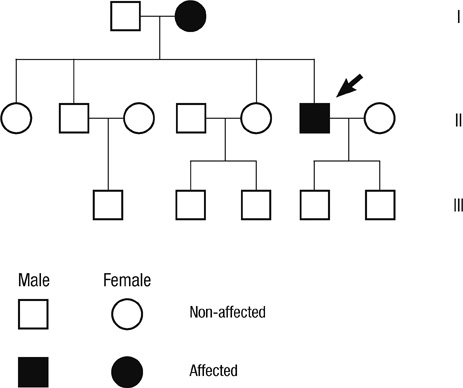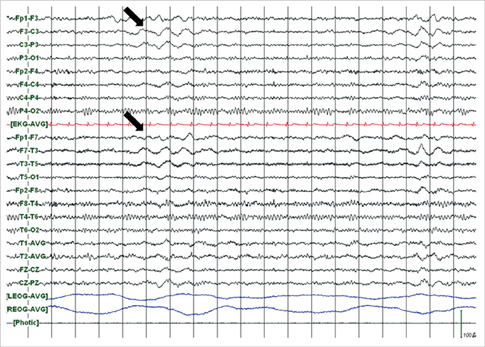J Korean Med Sci.
2012 Sep;27(9):1124-1127. 10.3346/jkms.2012.27.9.1124.
Familial Hemiplegic Migraine with Prolonged Coma and Cerebellar Atrophy: CACNA1A T666M Mutation in a Korean Family
- Affiliations
-
- 1Department of Neurology, College of Medicine, Kangwon National University Hospital, Chuncheon, Korea. dr.kim94@gmail.com
- 2Department of Laboratory Medicine & Genetics, Korea University College of Medicine, Korea University Guro Hospital, Seoul, Korea.
- 3Department of Laboratory Medicine, College of Medicine, Kangwon National University Hospital, Chuncheon, Korea.
- 4Department of Radiology, College of Medicine, Kangwon National University Hospital, Chuncheon, Korea.
- 5Department of Neurology, College of Medicine, Inha University Hospital, Incheon, Korea.
- KMID: 1782151
- DOI: http://doi.org/10.3346/jkms.2012.27.9.1124
Abstract
- We report the first Korean patient with familial hemiplegic migraine type 1, with clinical and multimodal imaging findings. A 43-yr-old man was admitted for right hemianopia and aphasia, followed by coma. MRI showed only cerebellar atrophy. CT angiography showed mild vasodilation of intracranial blood vessels and increased vascularity in the left hemisphere and perfusion-weighted imaging showed elevated cerebral blood flow. Gene analysis of the patient and his mother led to the identification of a heterozygous point mutation (1997C-->T, T666M) in exon 16 of the CACNA1A gene. Familial hemiplegic migraine should be considered in patients with episodic neurological dysfunction with cerebellar atrophy.
MeSH Terms
-
Asian Continental Ancestry Group/*genetics
Atrophy/genetics/metabolism
Calcium Channels/*genetics
Cerebellum/blood supply/*pathology
Cerebral Angiography
Coma/*diagnosis
Exons
Heterozygote
Humans
Magnetic Resonance Imaging
Male
Migraine with Aura/*diagnosis/genetics
Point Mutation
Republic of Korea
Tomography, X-Ray Computed
Calcium Channels
Figure
Cited by 1 articles
-
Postoperative Transient Neurologic Dysfunction: A Proposal for Pathophysiology
Ji Hoon Phi, Seung Jin Lee, Hyun-Seung Kang, Jeong Eun Kim, Seung-Ki Kim, Won-Sang Cho, Seo-Young Lee
J Clin Neurol. 2018;14(3):393-400. doi: 10.3988/jcn.2018.14.3.393.
Reference
-
1. Thomsen LL, Eriksen MK, Roemer SF, Andersen I, Olesen J, Russell MB. A population-based study of familial hemiplegic migraine suggests revised diagnostic criteria. Brain. 2002. 125:1379–1391.2. Ducros A, Denier C, Joutel A, Cecillon M, Lescoat C, Vahedi K, Darcel F, Vicaut E, Bousser MG, Tournier-Lasserve E. The clinical spectrum of familial hemiplegic migraine associated with mutations in a neuronal calcium channel. N Engl J Med. 2001. 345:17–24.3. Russell MB, Ducros A. Sporadic and familial hemiplegic migraine: pathophysiological mechanisms, clinical characteristics, diagnosis, and management. Lancet Neurol. 2011. 10:457–470.4. Sa-Kong Y, Lee BH, Bae SN, Lee KW, Nam SO. A case of familial hemiplegic migraine. J Korean Child Neurol Soc. 2003. 11:367–371.5. Kim JM, Kim JS, Ki CS, Jeon BS. Episodic ataxia type 2 due to a deletion mutation in the CACNA1A gene in a Korean family. J Clin Neurol. 2006. 2:268–271.6. Koh SH, Kim HT, Kim SH, Lee GY, Kim J, Kim MH. Spinocerebellar ataxia type 6 and episodic ataxia type 2 in a Korean family. J Korean Med Sci. 2001. 16:809–813.7. Romaniello R, Zucca C, Tonelli A, Bonato S, Baschirotto C, Zanotta N, Epifanio R, Righini A, Bresolin N, Bassi MT, et al. A wide spectrum of clinical, neurophysiological and neuroradiological abnormalities in a family with a novel CACNA1A mutation. J Neurol Neurosurg Psychiatry. 2010. 81:840–843.8. Pietrobon D, Striessnig J. Neurobiology of migraine. Nat Rev Neurosci. 2003. 4:386–398.9. Mullner C, Broos LA, van den Maagdenberg AM, Striessnig J. Familial hemiplegic migraine type 1 mutations K1336E, W1684R, and V1696I alter Cav2.1 Ca2+ channel gating: evidence for beta-subunit isoform-specific effects. J Biol Chem. 2004. 279:51844–51850.10. Vincent M, Hadjikhani N. The cerebellum and migraine. Headache. 2007. 47:820–833.11. Headache Classification Subcommittee of the International Headache Society. The International Classification of Headache Disorders: 2nd edition. Cephalalgia. 2004. 24:Suppl 1. 9–160.12. Bradshaw P, Parsons M. Hemiplegic migraine, a clinical study. Q J Med. 1965. 34:65–85.13. Kirchmann M. Migraine with aura: new understanding from clinical epidemiologic studies. Curr Opin Neurol. 2006. 19:286–293.14. Thomsen LL, Ostergaard E, Olesen J, Russell MB. Evidence for a separate type of migraine with aura: sporadic hemiplegic migraine. Neurology. 2003. 60:595–601.15. Butteriss DJ, Ramesh V, Birchall D. Serial MRI in a case of familial hemiplegic migraine. Neuroradiology. 2003. 45:300–303.16. Hsu DA, Stafstrom CE, Rowley HA, Kiff JE, Dulli DA. Hemiplegic migraine: hyperperfusion and abortive therapy with intravenous verapamil. Brain Dev. 2008. 30:86–90.17. Kumar G, Topper L, Maytal J. Familial hemiplegic migraine with prolonged aura and multimodality imaging: a case report. Headache. 2009. 49:139–142.18. Oberndorfer S, Wober C, Nasel C, Asenbaum S, Lahrmann H, Fueger B, Grisold W. Familial hemiplegic migraine: follow-up findings of diffusion-weighted magnetic resonance imaging (MRI), perfusion-MRI and [99mTc] HMPAO-SPECT in a patient with prolonged hemiplegic aura. Cephalalgia. 2004. 24:533–539.19. Prodan CI, Holland NR, Lenaerts ME, Parke JT. Magnetic resonance angiogram evidence of vasospasm in familial hemiplegic migraine. J Child Neurol. 2002. 17:470–472.20. Zifkin B, Andermann E, Andermann F, Kirkham T. An autosomal dominant syndrome of hemiplegic migraine, nystagmus, and tremor. Ann Neurol. 1980. 8:329–332.




